Urry D.W. (Ed.) What Sustains Life? : Consilient Mechanisms for Protein-Based Machines and Materials
Подождите немного. Документ загружается.


9.4 Medical Applications
495
spective is that an antibody is made to react
at a site on the protein called an antigenic
determinant or epitope. Several distinct contact
points fixed in space, such as charges and
hydrophobic groups, constitute the epitope. To
fix those points in space in order to constitute
an epitope, an antibody must stop the motions
that are contributing to the favorable free
energy of the elastic protein-based polymer.
This constitutes a barrier to the interaction. In
sum, the energy of stabilization estimated
above for the two bands is 23kcal/mole. Even
if the barrier were one-fourth that sum, for
example, 5.8kcal/mole, the probabihty of inter-
action as required to identify such an epitope
would decrease by a factor of more than
500,000.
Our
hypothesis,
therefore,
is that the remark-
able biocompatibility of elastic protein-based
polymers
arises
from the presence of
mechani-
cal resonances
that
themselves are
a
result
of the
regular,
nonrandom structure of this family of
entropic
elastic
protein-based polymers.
9A3 A Consilient Approach to
Tissue Engineering
In the words of E.O. Wilson in 1998, "To the
extent that we depend on prosthetic devices
to keep ourselves and the biosphere alive,
we will render everything fragile."^^ The con-
silient approach to tissue engineering utilizes
biology's own materials and mechanisms, con-
cerned with tissue structure and function, to
achieve tissue restoration. It is made possible
by temporary functional scaffoldings composed
of biodegradable and biocompatible elastic
model proteins that are responsive to tissue
variables in the same manner as natural
proteins.
The materials of our approach are natural to
the tissue to be restored; they are protein-based
polymers that are progammably biodegradable;
in their swollen state they degrade to natural
amino acids without release of irritating acid
(as occurs with the commonly used polyglycohc
and polylactic acids); they are elastic and can
match the comphance of the natural
tissue;
they
are biocompatible (the basic sequence in its
contracted state appears to be simply ignored
by the host); and they can have introduced into
them biologically active peptide sequences in a
natural form as part of the designed protein
sequence.
The mechanisms whereby the materials func-
tion are common to the tissue to be restored,
that
is,
they exhibit the same hydrophobic asso-
ciation as occurs in protein structure formation
and function, and the elasticity is due to
damping of internal chain dynamics rather than
due to random chain networks. As protein
function itself is central to cellular function,
this allows elastic protein-based materials in
concert with natural cells to achieve tissue
restoration in a manner entirely coherent with
fundamental relationships between cells and
their natural extracellular matrix.
The materials are fashioned into temporary
functional scaffoldings into which the natural
cells can migrate, attach, spread, and sense the
forces to which the temporary functional
scaf-
folding is subjected, and the cells in response
turn on the genes to produce an extracellular
matrix sufficient to sustain those forces. There-
by the natural cells remodel the temporary
functional scaffolding into a natural tissue.
9.4.3.1 Elastic Protein-based Polymers
Fashioned as Tubes, Sheets, and Fibers
9.4.3.1.1 Elastic Protein-based Polymers
as Tubes
By use of appropriate molds, elastic protein-
based polymers can be shaped into cross-linked
tubes of the desired shape and with a range of
elastic moduli, as shown in Figure 9.18. The
elastic moduH of tube A is about 2 x
10^
Pa, that
of tube B 6 X
10^
Pa, and that of tube C 2 x
10^
Pa, whereas that of the femoral artery is in
the range of 4 to 6 x
10^
Pa.^^'^^
9.4.3.1.2 Elastic Protein-based Polymers
as Sheets
A sheet of 20Mrad y-irradiation cross-linked
(GVGVP)25i, that
is,
X2'-(GVGVP)25i,
is
shown
in Figure 5.14 and a disk of this material con-
taining a human ureteral explant (see Figure
9.36A, below) is used in the simulated urinary
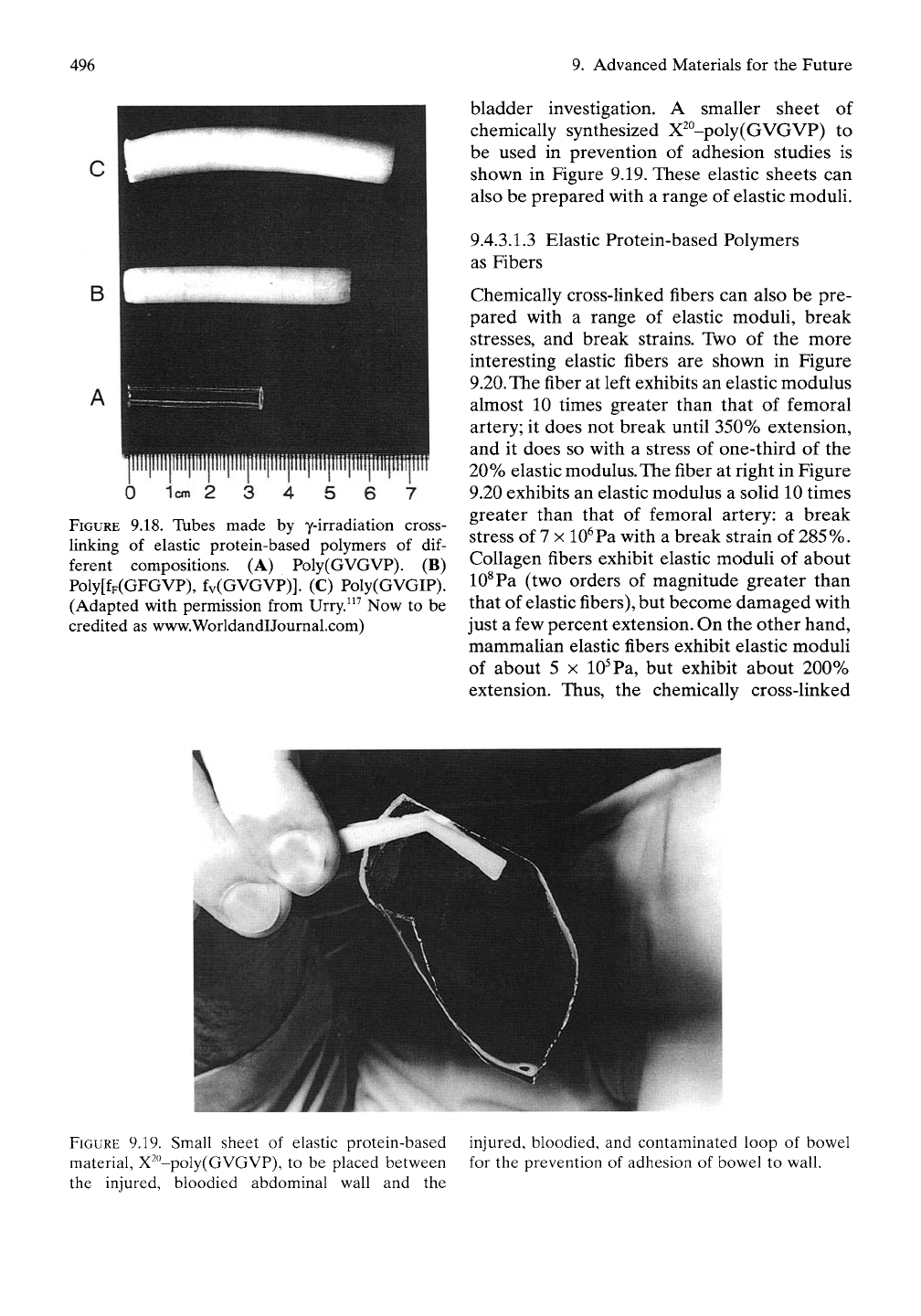
496
9. Advanced Materials for the Future
B
FIGURE 9.18. Tubes made by y-irradiation cross-
linking of elastic protein-based polymers of
dif-
ferent compositions. (A) Poly(GVGVP). (B)
Poly[fF(GFGVP), fv(GVGVP)]. (C) Poly(GVGIP).
(Adapted with permission from Urry.^^^ Now to be
credited as www.WorldandIJournal.com)
bladder investigation. A smaller sheet of
chemically synthesized X^^-poly(GVGVP) to
be used in prevention of adhesion studies is
shown in Figure 9.19. These elastic sheets can
also be prepared with a range of elastic moduli.
9.4.3.1.3 Elastic Protein-based Polymers
as Fibers
Chemically cross-Hnked fibers can also be pre-
pared with a range of elastic moduli, break
stresses, and break strains. Two of the more
interesting elastic fibers are shown in Figure
9.20.
The fiber at left exhibits an elastic modulus
almost 10 times greater than that of femoral
artery; it does not break until 350% extension,
and it does so with a stress of one-third of the
20%
elastic modulus. The fiber at right in Figure
9.20 exhibits an elastic modulus a solid 10 times
greater than that of femoral artery: a break
stress of 7
X
10^
Pa with a break strain of 285%.
Collagen fibers exhibit elastic moduli of about
10^
Pa (two orders of magnitude greater than
that of elastic fibers), but become damaged with
just a few percent extension. On the other hand,
mammalian elastic fibers exhibit elastic moduli
of about 5 X
10^
Pa, but exhibit about 200%
extension. Thus, the chemically cross-linked
FIGURE 9.19. Small sheet of elastic protein-based
material, X^^-poly(GVGVP), to be placed between
the injured, bloodied abdominal wall and the
injured, bloodied, and contaminated loop of bowel
for the prevention of adhesion of bowel to wall.
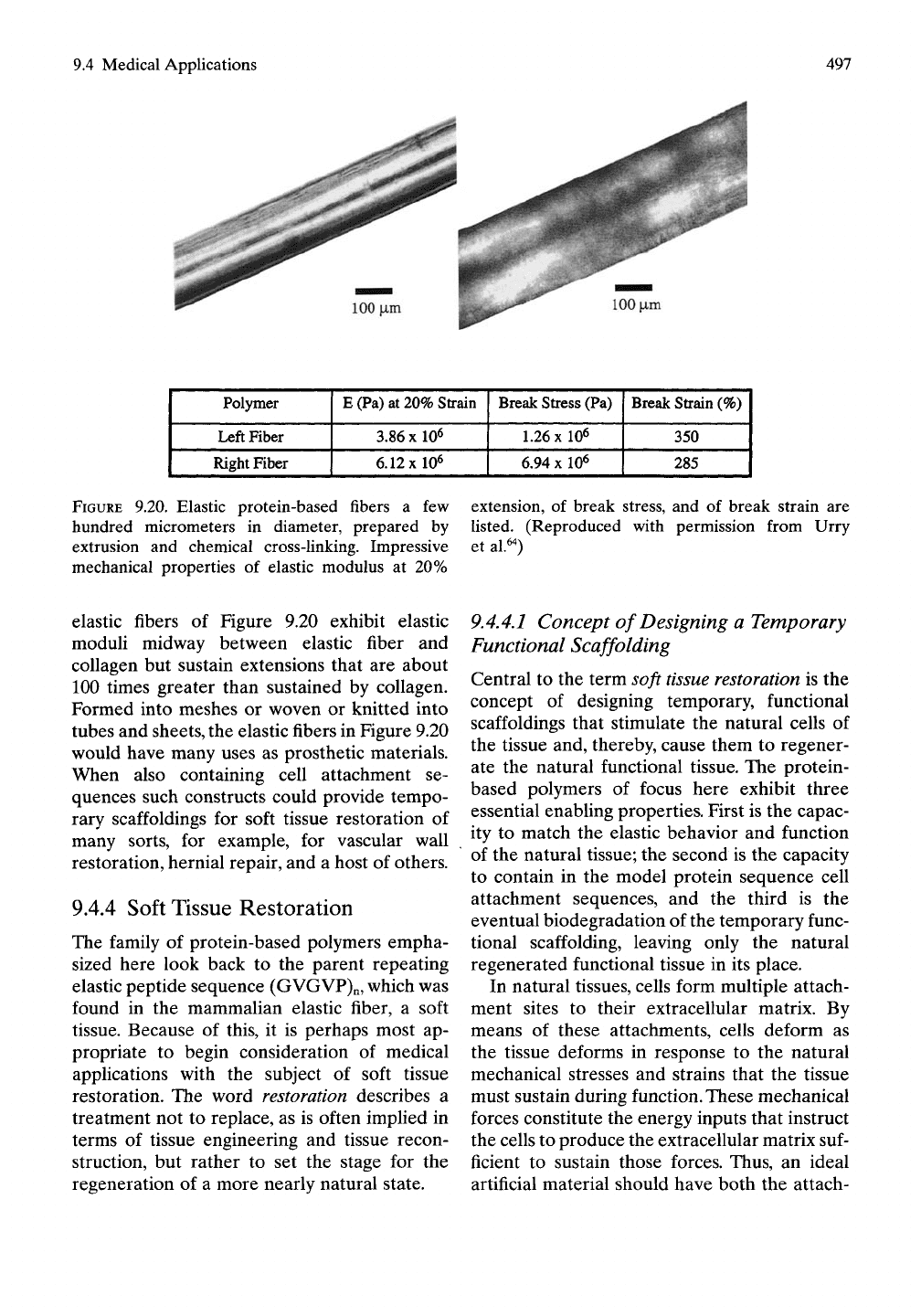
9.4 Medical Applications
497
100 |xm
Polymer
1 Left Fiber
Right Fiber
E (Pa) at
20%
Strain
3.86
X
10^
6.12x10^
Break Stress (Pa)
1.26 xlO^
6.94
X
10^
Break Strain (%)
1
350
1
285
1
FIGURE
9.20. Elastic protein-based fibers a few
hundred micrometers in diameter, prepared by
extrusion and chemical cross-linking. Impressive
mechanical properties of elastic modulus at 20%
extension, of break stress, and of break strain are
listed. (Reproduced with permission from Urry
et al.^0
elastic fibers of Figure 9.20 exhibit elastic
moduli midway between elastic fiber and
collagen but sustain extensions that are about
100 times greater than sustained by collagen.
Formed into meshes or woven or knitted into
tubes and sheets, the elastic fibers in Figure 9.20
would have many uses as prosthetic materials.
When also containing cell attachment se-
quences such constructs could provide tempo-
rary scaffoldings for soft tissue restoration of
many sorts, for example, for vascular wall
restoration, hernial repair, and a host of others.
9.4.4 Soft Tissue Restoration
The family of protein-based polymers empha-
sized here look back to the parent repeating
elastic peptide sequence (GVGVP)n, which was
found in the mammalian elastic fiber, a soft
tissue. Because of this, it is perhaps most ap-
propriate to begin consideration of medical
applications with the subject of soft tissue
restoration. The word restoration describes a
treatment not to replace, as is often implied in
terms of tissue engineering and tissue recon-
struction, but rather to set the stage for the
regeneration of a more nearly natural state.
9.4.4.1 Concept of Designing a Temporary
Functional Scaffolding
Central to the term soft tissue restoration is the
concept of designing temporary, functional
scaffoldings that stimulate the natural cells of
the tissue and, thereby, cause them to regener-
ate the natural functional tissue. The protein-
based polymers of focus here exhibit three
essential enabling properties. First is the capac-
ity to match the elastic behavior and function
of the natural tissue; the second is the capacity
to contain in the model protein sequence cell
attachment sequences, and the third is the
eventual biodegradation of the temporary func-
tional scaffolding, leaving only the natural
regenerated functional tissue in its place.
In natural tissues, cells form multiple attach-
ment sites to their extracellular matrix. By
means of these attachments, cells deform as
the tissue deforms in response to the natural
mechanical stresses and strains that the tissue
must sustain during function. These mechanical
forces constitute the energy inputs that instruct
the cells to produce the extracellular matrix
suf-
ficient to sustain those forces. Thus, an ideal
artificial material should have both the attach-
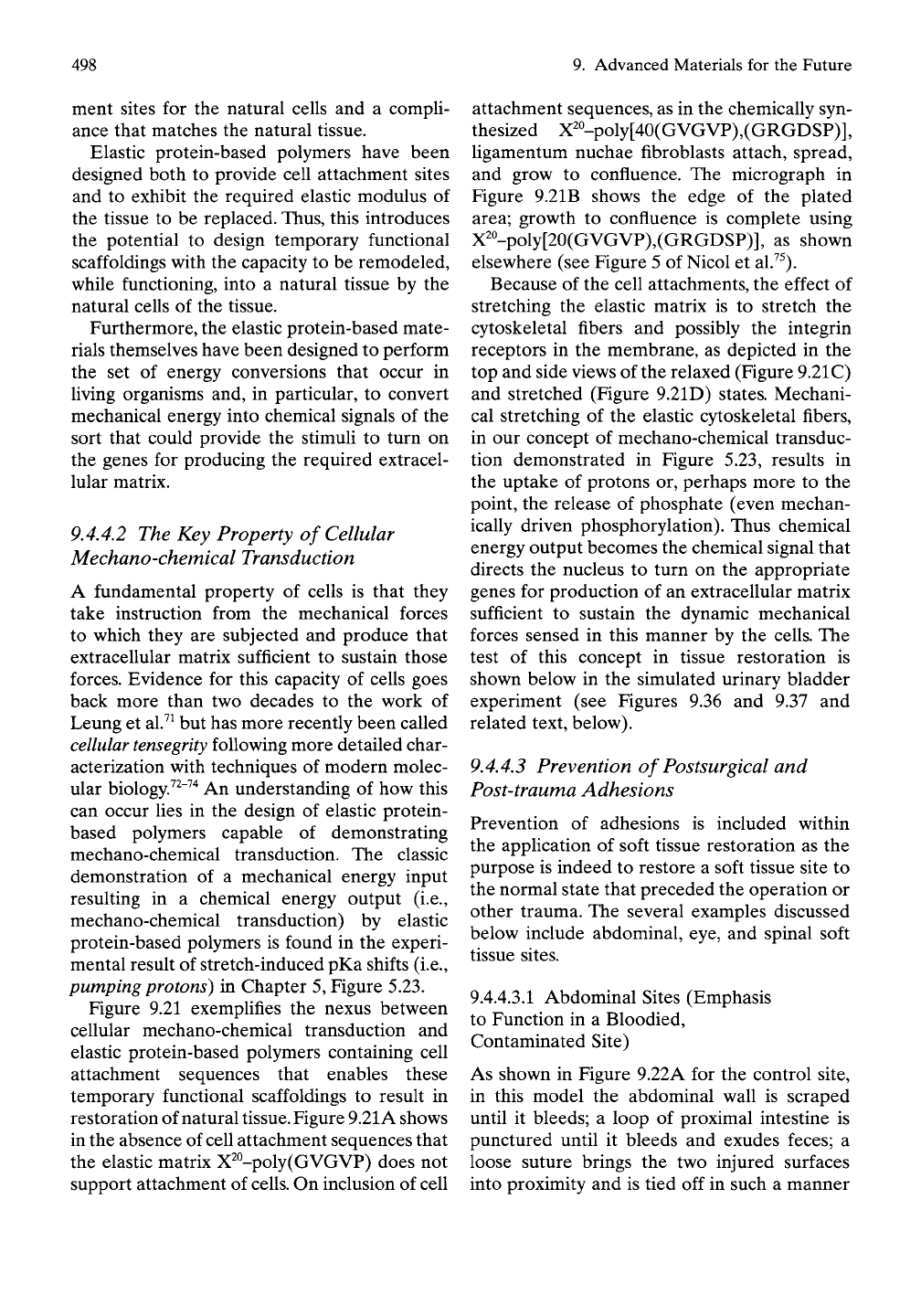
498
9. Advanced Materials for the Future
ment sites for the natural cells and a compU-
ance that matches the natural tissue.
Elastic protein-based polymers have been
designed both to provide cell attachment sites
and to exhibit the required elastic modulus of
the tissue to be replaced. Thus, this introduces
the potential to design temporary functional
scaffoldings with the capacity to be remodeled,
while functioning, into a natural tissue by the
natural cells of the tissue.
Furthermore, the elastic protein-based mate-
rials themselves have been designed to perform
the set of energy conversions that occur in
living organisms and, in particular, to convert
mechanical energy into chemical signals of the
sort that could provide the stimuH to turn on
the genes for producing the required extracel-
lular matrix.
9.4.4.2 The Key Property of Cellular
Mechano-chemical Transduction
A fundamental property of cells is that they
take instruction from the mechanical forces
to which they are subjected and produce that
extracellular matrix sufficient to sustain those
forces. Evidence for this capacity of cells goes
back more than two decades to the work of
Leung et al.^^ but has more recently been called
cellular tensegrity following more detailed char-
acterization with techniques of modern molec-
ular biology.^^"^"^ An understanding of how this
can occur lies in the design of elastic protein-
based polymers capable of demonstrating
mechano-chemical transduction. The classic
demonstration of a mechanical energy input
resulting in a chemical energy output (i.e.,
mechano-chemical transduction) by elastic
protein-based polymers is found in the experi-
mental result of stretch-induced pKa shifts (i.e.,
pumping protons) in Chapter 5, Figure 5.23.
Figure 9.21 exemplifies the nexus between
cellular mechano-chemical transduction and
elastic protein-based polymers containing cell
attachment sequences that enables these
temporary functional scaffoldings to result in
restoration of natural
tissue.
Figure 9.21 A shows
in the absence of cell attachment sequences that
the elastic matrix X^^-poly(GVGVP) does not
support attachment of
cells.
On inclusion of cell
attachment sequences, as in the chemically syn-
thesized X'^-poly[40(GVGVP),(GRGDSP)],
ligamentum nuchae fibroblasts attach, spread,
and grow to confluence. The micrograph in
Figure 9.21B shows the edge of the plated
area; growth to confluence is complete using
X2^-poly[20(GVGVP),(GRGDSP)], as shown
elsewhere (see Figure 5 of Nicol et
al.^^).
Because of the cell attachments, the effect of
stretching the elastic matrix is to stretch the
cytoskeletal fibers and possibly the integrin
receptors in the membrane, as depicted in the
top and side views of the relaxed (Figure 9.21C)
and stretched (Figure 9.21D) states. Mechani-
cal stretching of the elastic cytoskeletal fibers,
in our concept of mechano-chemical transduc-
tion demonstrated in Figure 5.23, results in
the uptake of protons or, perhaps more to the
point, the release of phosphate (even mechan-
ically driven phosphorylation). Thus chemical
energy output becomes the chemical signal that
directs the nucleus to turn on the appropriate
genes for production of an extracellular matrix
sufficient to sustain the dynamic mechanical
forces sensed in this manner by the cells. The
test of this concept in tissue restoration is
shown below in the simulated urinary bladder
experiment (see Figures 9.36 and 9.37 and
related text, below).
9.4.4.3 Prevention of Postsurgical and
Post-trauma Adhesions
Prevention of adhesions is included within
the application of soft tissue restoration as the
purpose is indeed to restore a soft tissue site to
the normal state that preceded the operation or
other trauma. The several examples discussed
below include abdominal, eye, and spinal soft
tissue sites.
9.4.4.3.1 Abdominal Sites (Emphasis
to Function in a Bloodied,
Contaminated Site)
As shown in Figure 9.22A for the control site,
in this model the abdominal wall is scraped
until it bleeds; a loop of proximal intestine is
punctured until it bleeds and exudes feces; a
loose suture brings the two injured surfaces
into proximity and is tied off in such a manner
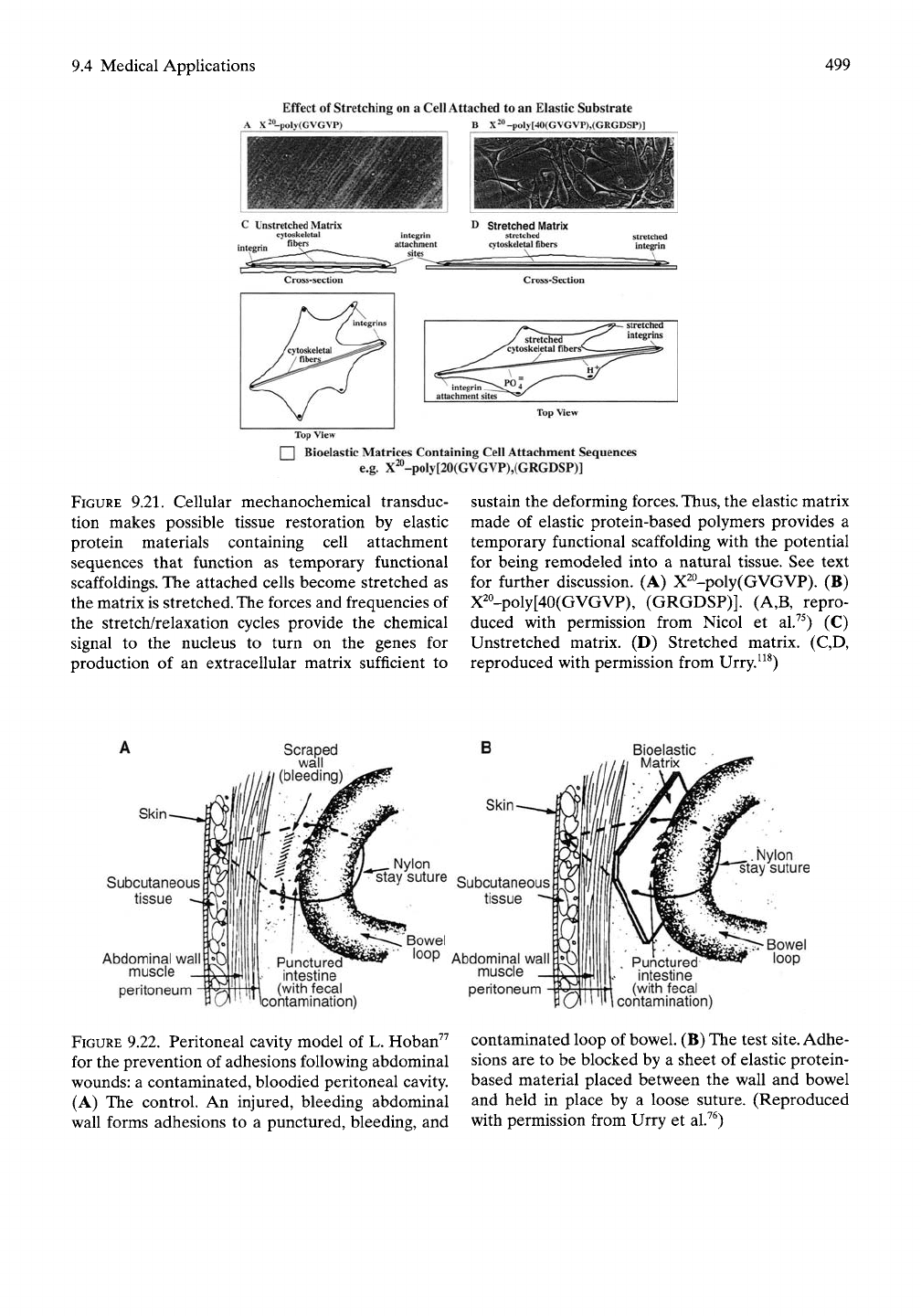
9.4 Medical Applications 499
Effect of Stretching on a Cell Attached to an Elastic Substrate
"-poly(GVGVP) B X^"-poly[40(GVGVP),(GRGDSP)]
C Unstretched Matrix
cytoskeletal
integrin «»^«
integrin
Stretched Matrix
stretched
cytoskeletal fibers
Top View
Top View
I I Bioelastic Matrices Containing
Cell
Attachment Sequences
e.g. x2"-poly[20(GVGVP),(GRGDSP)]
FIGURE
9.21. Cellular mechanochemical transduc-
tion makes possible tissue restoration by elastic
protein materials containing cell attachment
sequences that function as temporary functional
scaffoldings. The attached cells become stretched as
the matrix is stretched.
The
forces and frequencies of
the stretch/relaxation cycles provide the chemical
signal to the nucleus to turn on the genes for
production of an extracellular matrix sufficient to
sustain the deforming forces.
Thus,
the elastic matrix
made of elastic protein-based polymers provides a
temporary functional scaffolding with the potential
for being remodeled into a natural tissue. See text
for further discussion. (A) X^^-polyCGVGVP). (B)
X2°-poly[40(GVGVP), (GRGDSP)]. (A,B, repro-
duced with permission from Nicol et al.^^) (C)
Unstretched matrix. (D) Stretched matrix. (C,D,
reproduced with permission from Urry.^^^)
Scraped
wall
(bleeding)
Skin
Subcutaneous
tissue -^
Abdominal wall
muscle
peritoneum
B
Skin
Bioelastic
Matrix
j^
Nylon
stay suture Subcutaneous
tissue ^
Punctured
intestine
(with fecal
'contamination)
Bowel
'OOP Abdominal wall
muscle
peritoneum
Punctured
intestine
(with fecal
1
contamination)
Nylon
stay suture
Bowel
loop
FIGURE 9.22. Peritoneal cavity model of L. Hoban^^
for the prevention of adhesions following abdominal
wounds: a contaminated, bloodied peritoneal cavity.
(A) The control. An injured, bleeding abdominal
wall forms adhesions to a punctured, bleeding, and
contaminated loop of
bowel.
(B) The test
site.
Adhe-
sions are to be blocked by a sheet of elastic protein-
based material placed between the wall and bowel
and held in place by a loose suture. (Reproduced
with permission from Urry et al.^^)
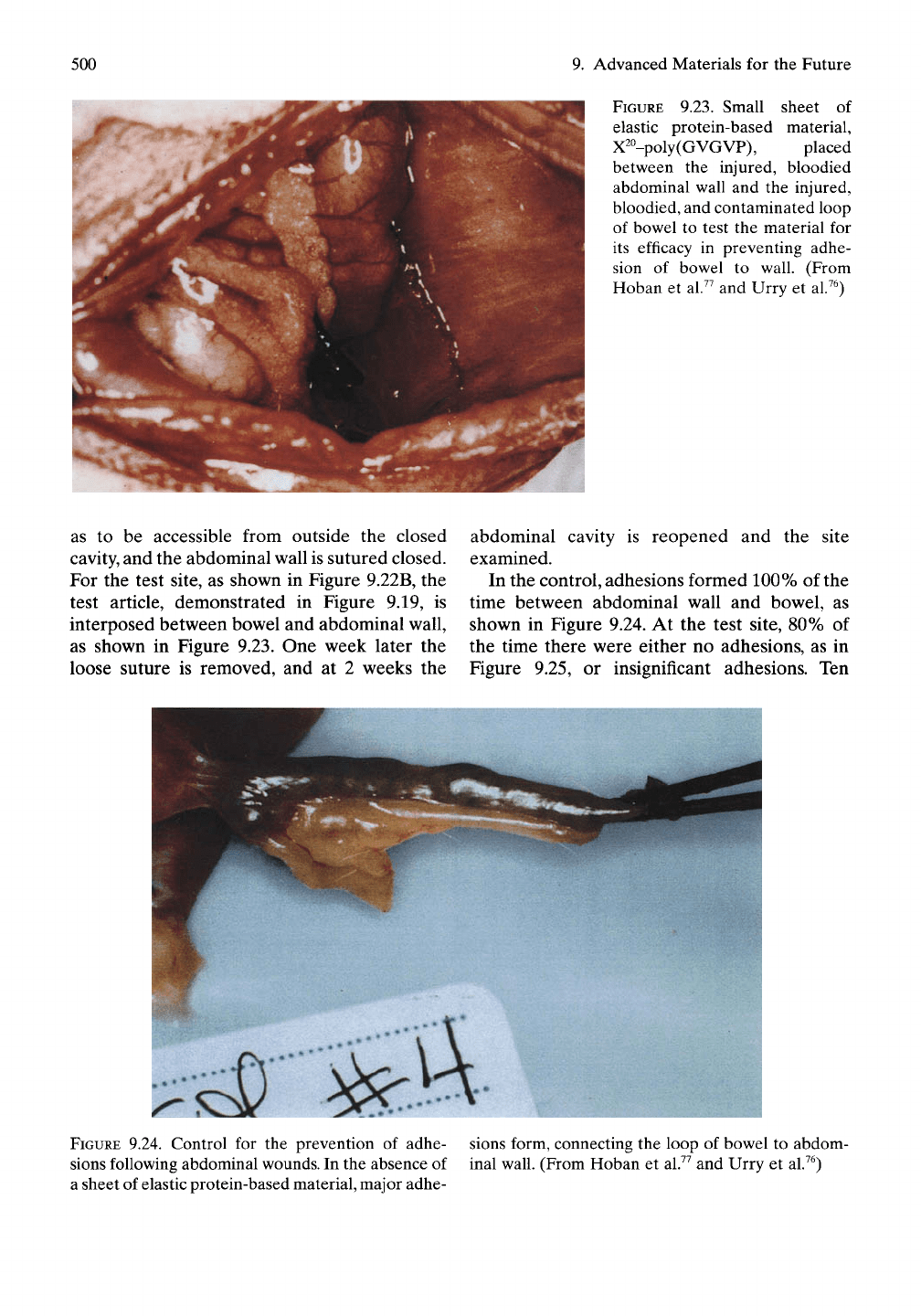
500
9. Advanced Materials for the Future
FIGURE
9.23. Small sheet of
elastic protein-based material,
X2°-poly(GVGVP), placed
between the injured, bloodied
abdominal wall and the injured,
bloodied, and contaminated loop
of bowel to test the material for
its efficacy in preventing adhe-
sion of bowel to wall. (From
Hoban et al.^^ and Urry et al.^^)
as to be accessible from outside the closed
cavity,
and the abdominal wall
is
sutured closed.
For the test site, as shown in Figure 9.22B, the
test article, demonstrated in Figure 9.19, is
interposed between bowel and abdominal wall,
as shown in Figure 9.23. One week later the
loose suture is removed, and at 2 weeks the
abdominal cavity is reopened and the site
examined.
In the control, adhesions formed 100% of the
time between abdominal wall and bowel, as
shown in Figure 9.24. At the test site, 80% of
the time there were either no adhesions, as in
Figure 9.25, or insignificant adhesions. Ten
FIGURE
9.24. Control for the prevention of adhe-
sions following abdominal wounds. In the absence of
a sheet of elastic protein-based material, major adhe-
sions form, connecting the loop of bowel to abdom-
inal wall. (From Hoban et al.^^ and Urry et al.^^)
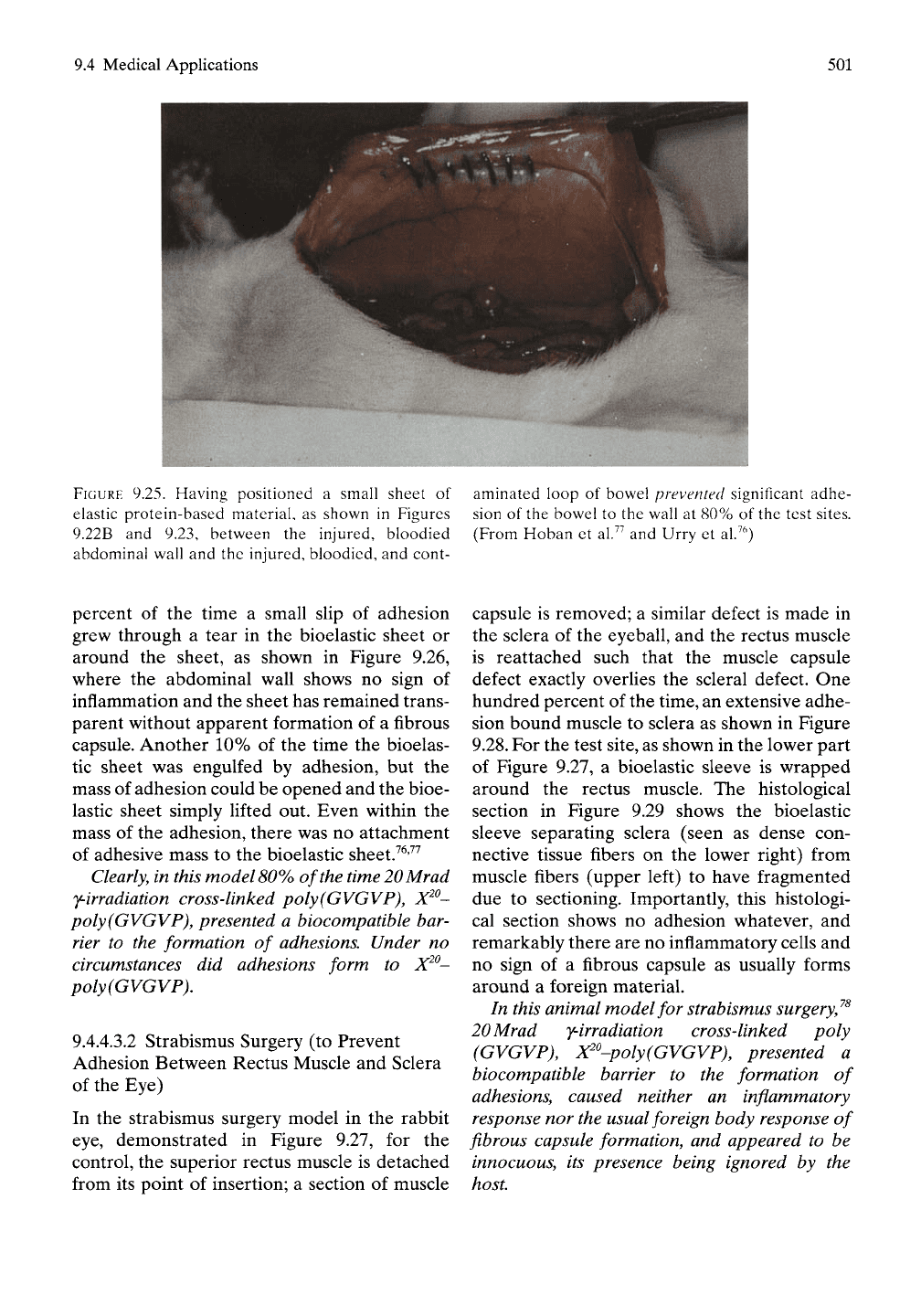
9.4 Medical Applications
501
FIGURE
9.25. Having positioned a small sheet of
elastic protein-based material, as shown in Figures
9.22B and 9.23, between the injured, bloodied
abdominal wall and the injured, bloodied, and cont-
aminated loop of bowel prevented significant adhe-
sion of the bowel to the wall at 80% of the test sites.
(From Hoban et al.^^ and Urry et al.^^)
percent of the time a small slip of adhesion
grew through a tear in the bioelastic sheet or
around the sheet, as shown in Figure 9.26,
where the abdominal wall shows no sign of
inflammation and the sheet has remained trans-
parent without apparent formation of a fibrous
capsule. Another 10% of the time the bioelas-
tic sheet was engulfed by adhesion, but the
mass of adhesion could be opened and the bioe-
lastic sheet simply lifted out. Even within the
mass of the adhesion, there was no attachment
of adhesive mass to the bioelastic sheet.^^'^^
Clearly, in this model 80% of the time 20 Mr ad
y-irradiation
cross-linked poly(GVGVP), X^^-
poly(GVGVP), presented a biocompatible bar-
rier to the formation of adhesions. Under no
circumstances did adhesions form to X^^-
poly(GVGVP),
9.4.4.3.2 Strabismus Surgery (to Prevent
Adhesion Between Rectus Muscle and Sclera
of the Eye)
In the strabismus surgery model in the rabbit
eye,
demonstrated in Figure 9.27, for the
control, the superior rectus muscle is detached
from its point of insertion; a section of muscle
capsule is removed; a similar defect is made in
the sclera of the eyeball, and the rectus muscle
is reattached such that the muscle capsule
defect exactly overhes the scleral defect. One
hundred percent of the time, an extensive adhe-
sion bound muscle to sclera as shown in Figure
9.28. For the test site, as shown in the lower part
of Figure 9.27, a bioelastic sleeve is wrapped
around the rectus muscle. The histological
section in Figure 9.29 shows the bioelastic
sleeve separating sclera (seen as dense con-
nective tissue fibers on the lower right) from
muscle fibers (upper left) to have fragmented
due to sectioning. Importantly, this histologi-
cal section shows no adhesion whatever, and
remarkably there are no inflammatory cells and
no sign of a fibrous capsule as usually forms
around a foreign material.
In this animal model for strabismus surgery/^
20Mrad y-irradiation cross-linked poly
(GVGVP),
X'^-poly(GVGVP), presented a
biocompatible barrier to the formation of
adhesions, caused neither an inflammatory
response nor the usual foreign body response of
fibrous capsule formation, and appeared to be
innocuous, its presence being ignored by the
host.
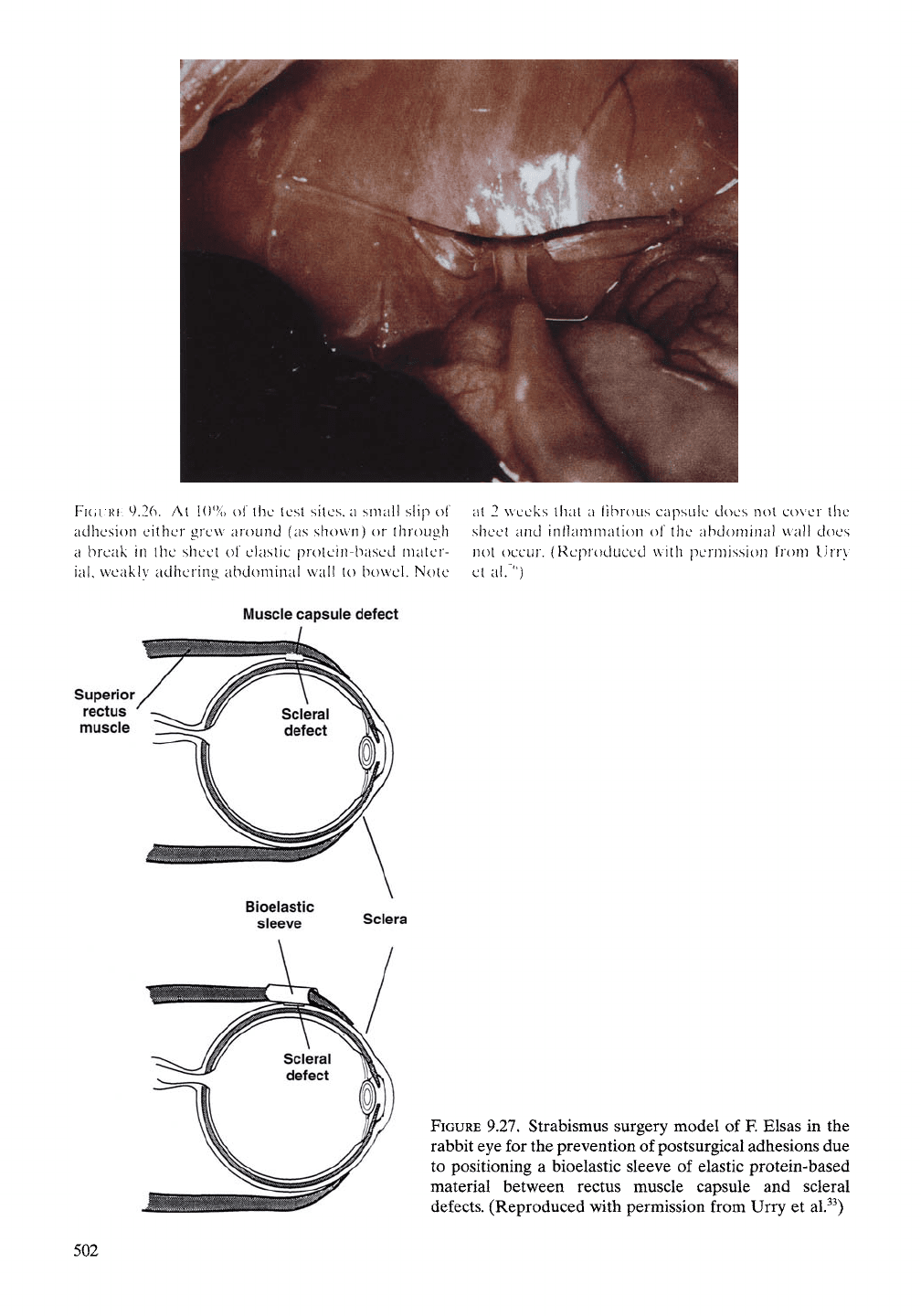
FKJUKI:
9.26. At \{)% of the lest sites, a small slip oi'
adhesion either grew around (as shown) or through
a break in the sheet of elastie protein-based mater-
ial,
weakly adhering abdominal wall to bowel. Note
at 2 weeks that a librous eapsule does not eover the
sheet and inflammation of the abdominal wall does
not oeeur. (Reprodueed with permission from Urry
et al.^')
Muscle
capsule
defect
Superior
rectus
muscle
Bioeiastic
sleeve
Sclera
FIGURE
9.27. Strabismus surgery model of F. Elsas in the
rabbit eye for the prevention of postsurgical adhesions due
to positioning a bioeiastic sleeve of elastic protein-based
material between rectus muscle capsule and scleral
defects. (Reproduced with permission from Urry et al.^^)
502

9.4 Medical Applications
503
FIGURE
9.28. Control site for the prevention of adhe-
sions in a strabismus surgery model in the rabbit eye
showing, in the absence of a bioelastic sleeve, exten-
sive adhesion between muscle and scleral defects.
(Reproduced with permission from Elsas et al.^^
With permission of Slack Incorporated.)
FIGURE
9.29. Demonstration of the efficacy, in a stra-
bismus surgery model in the rabbit eye created by
F.
Elsas, of a bioelastic sleeve of an elastic protein-
based material to prevent adhesion between scleral
and rectus muscle defects. Note absence of adhesion
and the complete absence of an inflammatory
response. (Reproduced with permission from Elsas
et al.''^ With permission of Slack Incorporated.)
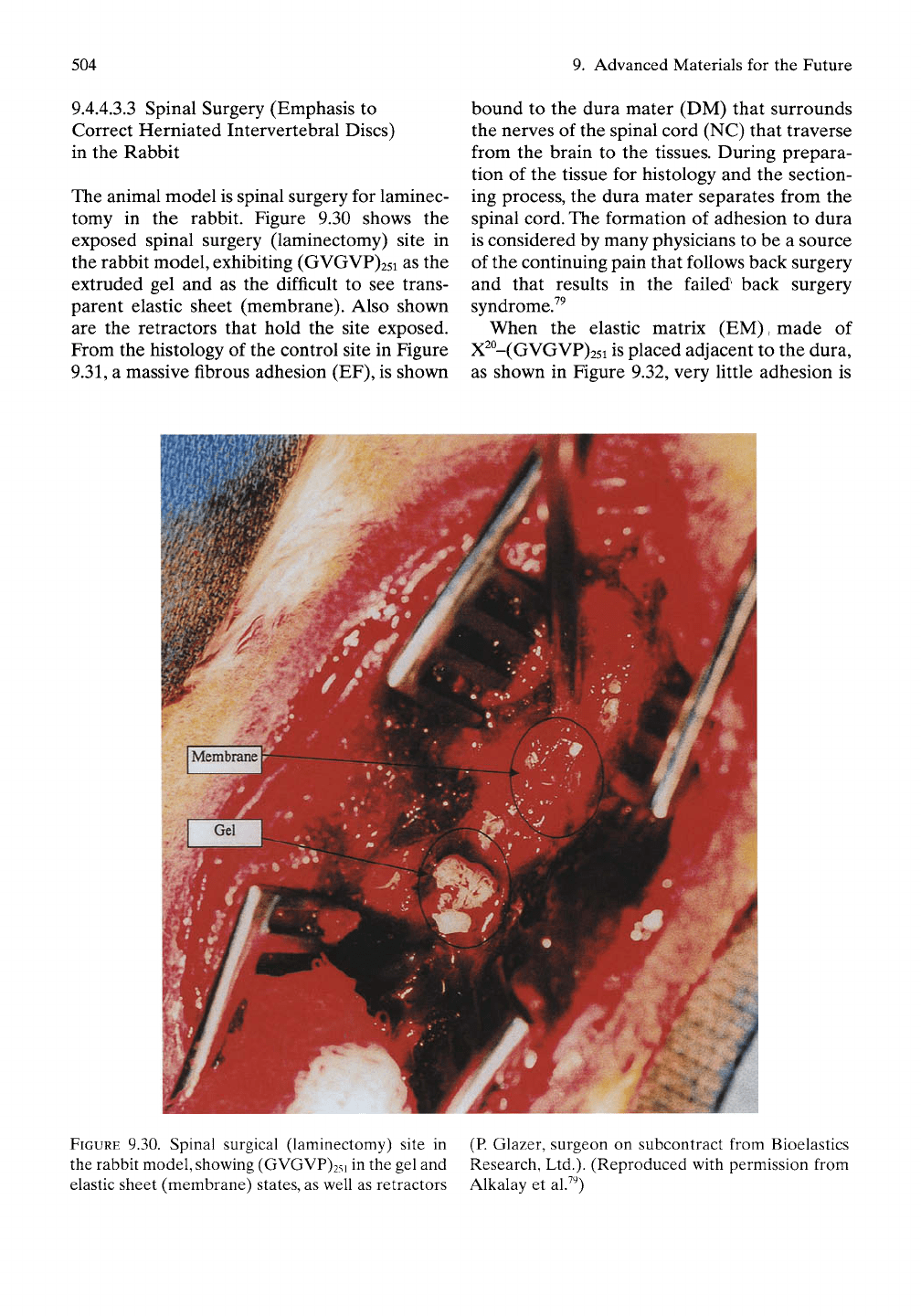
504
9. Advanced Materials for the Future
9.4.4.3.3 Spinal Surgery (Emphasis to
Correct Herniated Intervertebral Discs)
in the Rabbit
The animal model is spinal surgery for laminec-
tomy in the rabbit. Figure 9.30 shows the
exposed spinal surgery (laminectomy) site in
the rabbit model, exhibiting (GVGVP)25i as the
extruded gel and as the difficult to see trans-
parent elastic sheet (membrane). Also shown
are the retractors that hold the site exposed.
From the histology of the control site in Figure
9.31,
a massive fibrous adhesion (EF), is shown
bound to the dura mater (DM) that surrounds
the nerves of the spinal cord (NC) that traverse
from the brain to the tissues. During prepara-
tion of the tissue for histology and the section-
ing process, the dura mater separates from the
spinal cord. The formation of adhesion to dura
is considered by many physicians to be a source
of the continuing pain that follows back surgery
and that results in the failed back surgery
syndrome.^^
When the elastic matrix (EM) made of
X2o_(GVGVP)25i is placed adjacent to the dura,
as shown in Figure 9.32, very little adhesion is
FIGURE 9.30. Spinal surgical (laminectomy) site in
the rabbit model, showing (GVGVP)25i in the gel and
elastic sheet (membrane) states, as well as retractors
(P.
Glazer, surgeon on subcontract from Bioelastics
Research, Ltd.). (Reproduced with permission from
Alkalay et al.''^)
